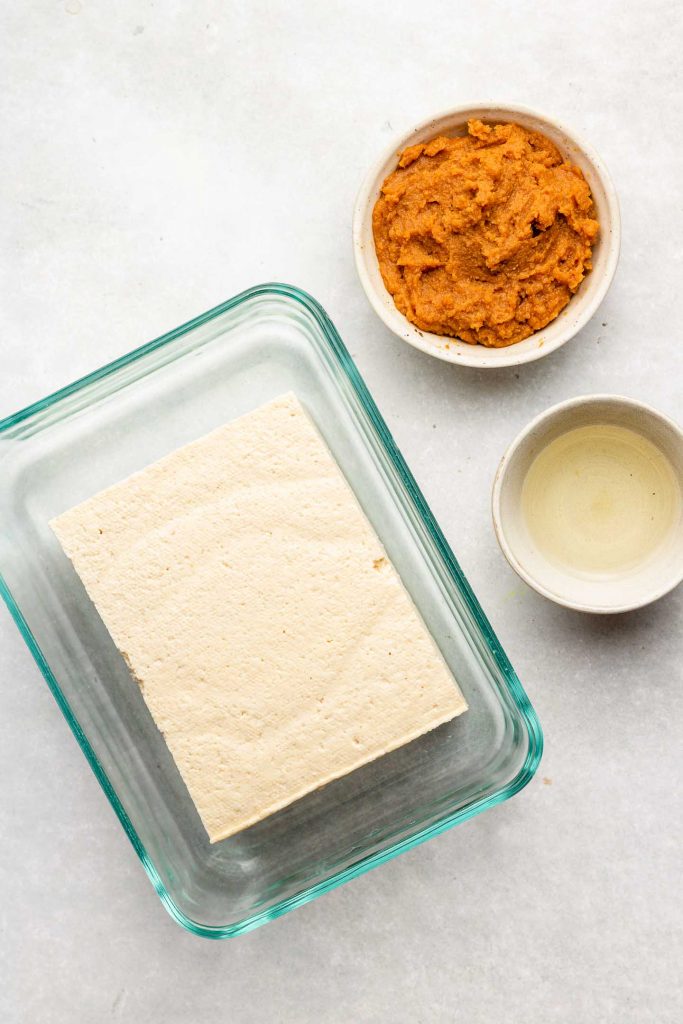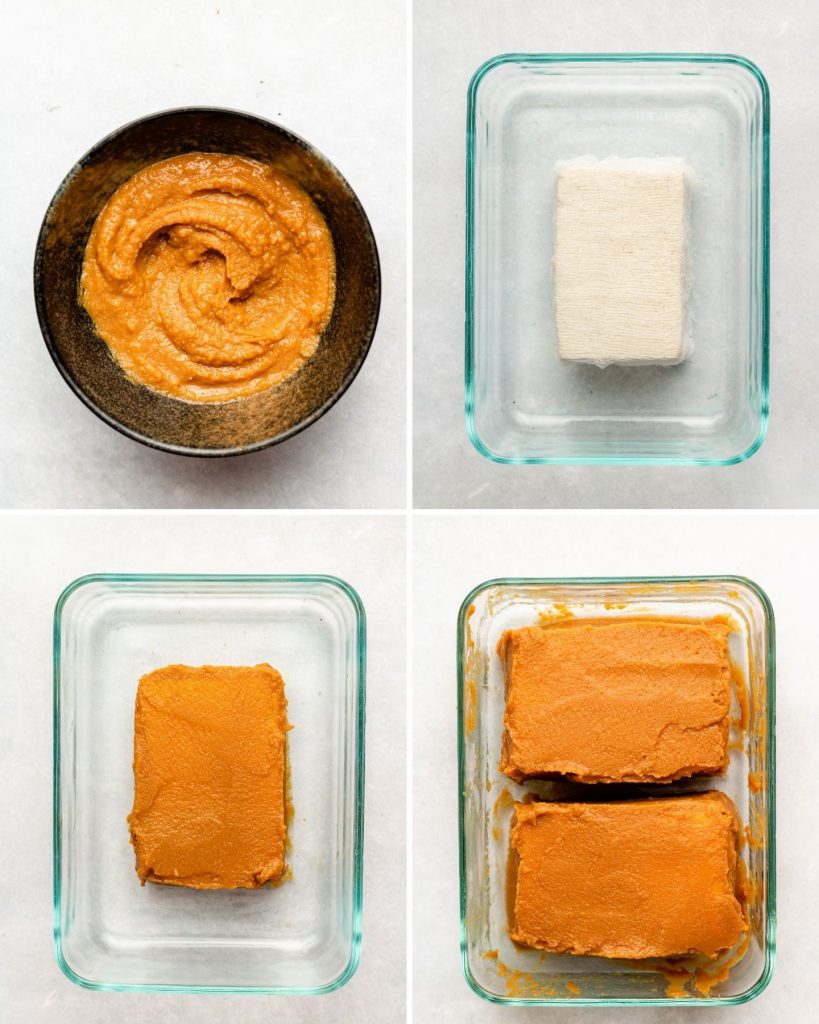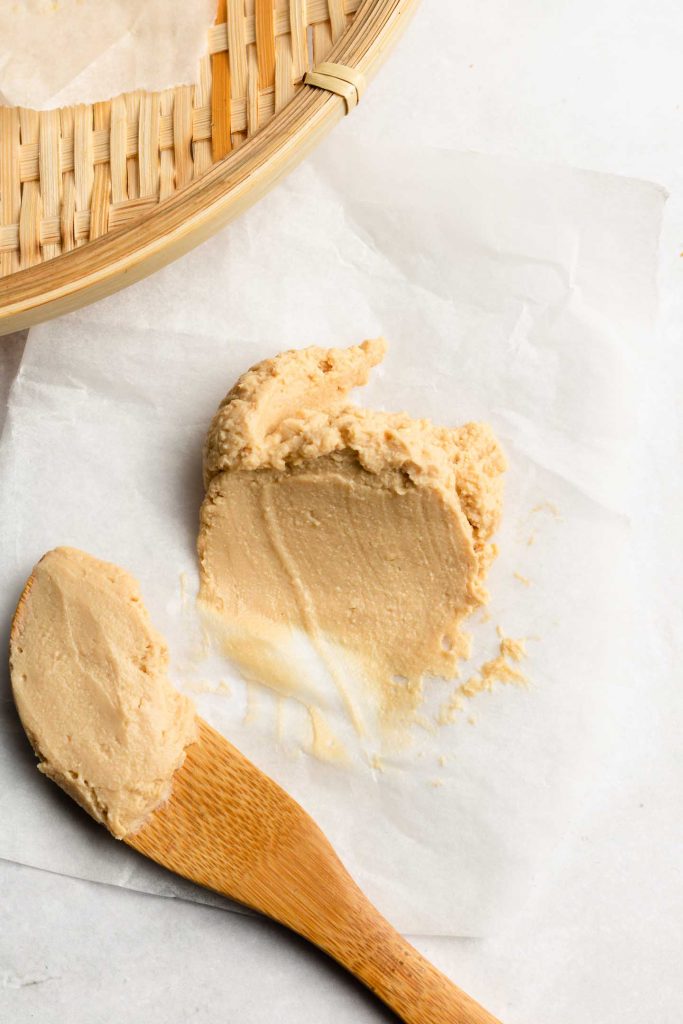
Learn how to make Misozuke (Miso Tofu Fermented Cheese) right in your own kitchen with this easy step-by-step guide!

Have you heard of misozuke? This cheese-like delicacy is originated in Fukuoka— which is where I first had the pleasure of trying it. It’s rich, umami, creamy, salty and tangy flavour is reminiscent of cream cheese & feta.
2 years ago when I visited Japan, I was talking to my uncle about this amazing tofu cream (that I constantly shared on instagram)– and I found out my uncle LOVES this stuff and has gotten to know the seller he purchases it from. He was kind enough to share essentially how you can make this ‘cheese’ at home with just a few simple ingredients. The past year, I’ve been experimenting with misozuke and I’m so excited to finally share this special dish today!
What is misozuke?
Essentially, it is tofu fermented with miso wrapped around it. It can be found either in ‘pickled’ form or ‘cream-cheese’ like texture– depending on where you purchase or try it.
How does miso paste turn tofu into something like cheese?! Keep reading to find out 🙂

How to Make Misozuke
The Ingredients
- Firm OR Extra Firm Tofu: I’ve tried making misozuke with both firm and extra firm tofu. Both work but the consistency will vary (depending on the brand as well). Extra firm tofu will yield a thicker, richer cheese (slightly more crumbly when cutting into it but still super creamy).
- Miso Paste: White or red smooth miso paste can be used. Red miso paste makes it slightly more saltier.
- Sake (optional): Can be omitted but does add to the cheese-like flavour.
- Sugar (optional): Balances out the saltiness and tanginess of the cheese.
- Herbs, spices & other flavourings (optional): See below for recommendations! Be sure to use organic zests and dried herbs if using.
Equipment
You don’t need any special equipment to make misozuke, just an air tight sterile container and cheesecloth.

The directions
- Mix the miso paste, sake, sugar and optional flavourings in a bowl until well combined.
- Remove the tofu from the package. Gently press out any excess liquid and pat it dry. (You can press out excess liquid if you are using firm for a richer consistency). Cut the tofu into two blocks. Wrap one or two layers of cheesecloth over each piece of tofu. Using only one layer will make the misozuke more salty. Spread a generous layer of miso paste on top of the cheesecloth. Be sure every part is covered so that no cheesecloth or tofu is exposed.
- Place in an air tight container and store in the fridge for 7 – 100 days, depending on how long you want to ferment it. Optionally, you can place a layer of paper towel into the Tupperware to remove the accumulated liquid easier.
- Every week, check the misozuke. If you see any liquid accumulating, carefully pour it out. Ensure that the block of tofu is still fully covered with miso and that the container is fry. If you accidentally scrape off some miso, cover it with more miso.
- After the fermentation period is over, unwrap the tofu and remove any remaining miso paste. Now it’s ready to serve!
Fermentation Period: How long should you ferment tofu cheese?
There are two types of tofu misozuke you can find in Japan:
- ‘Pickled’ Misozuke (short term <1 week): This is more so enjoyed as a snack or side dish. Typically eaten sliced or cubes alongside crackers or beer.
- Cured/Fermented Misozuke (long term 2+ months): Enjoyed as a spread like cream cheese or fancy cheeses like Brie. In Japan, some places ferment their miso tofu for up to two years!
These are some of the time frames I’ve experimented with that yield different texture and flavours:
- 1 week (7 days): Slightly creamier but still the texture of tofu. Not spread-able but can be eaten as a side dish/snack.
- 1 month (30 days): Spreadable but crumbly. A salty flavour has developed throughout the tofu.
- 2 months (60 days): Spreadable and creamy. Flavour has developed throughout the tofu and has some tanginess to it.
- 3 months (90 days): Very spreadable, rich and creamy. The flavour has intensified, gotten much saltier, tangier and has more umami.
- 110 days: Not much different than 3 months.
Summary: I found the best fermentation time to achieve that super rich, cream-cheese like texture to be anywhere from 90-100 days. However, if you want something like a block cheese (for snacking or crackers), you can get away with fermenting for a shorter period of time. Try different fermentation times to see which one you like best!
Troubleshooting & Mold
Be sure to monitor the misozuke at least once a week, ensuring the container is dry. If you see any liquid accumulating, pour it out. The container should be kept dry (you can layer some paper towel down to make this process easier).
I’ve never had a problem with growing lots of mold. Little spots of mold can be removed and replaced with fresh miso paste, but it is best to prevent any mold development.
Please use your best judgement when evaluating your misozuke as fermenting of any kind carries risks. When in doubt, toss it.

Tofu Cheese Flavour Variations
Once you’ve tried misozuke, I highly recommend trying out different flavours and variations! Here are a couple I’ve tried and loved (with flavour descriptions):
- Plain: Very creamy, salty but the most mild in flavour. Tangy, rich and easily spreadable. Reminiscent of cream cheese and feta.
- Lemon Zest: Slightly thicker, more tangy. Reminiscent of a rich cheesecake and feta.
- Yuzu Salt: Tangier and saltier. Texture similar to lemon zest.
- Umeboshi: Saltier and more umami. Slightly thicker in texture than the plain.
- Red pepper flakes: The thickest, creamiest and richest out of them all with a very subtle spiciness. Reminiscent of Brie or Camembert.
- Nori: Slightly more crumbly (but still creamy). Lots of umami flavour, slightly tangier and most similar to Wensleydale and Roquefort.
- Other (dried) herbs & spices: You can also add other herbs and spices for flavour! It will be very mild but I think garlic herb or dill would be delicious

Ways to serve misozuke
Misozuke can be served any way you would cheese! Here are some of my personal favourite ways and suggestions:
- cut into cubes (for pickled misozuke) or smear on crackers
- pair with beer, sake and wine!
- serve with vegetables or add to salads
- add it to dressings and sauces
- use it so pasta and casseroles (it bakes well!)
- spread it over pitas and pizza
- use it in sandwiches, wraps, bagels and toast
More Vegan Cheese Recipes to Try!
If you recreate this Misozuke recipe let me know how you liked it by leaving a comment and rating below or by tagging me on Instagram @Okonomikitchen, I love seeing all of your tasty recreations!
Hungry for more? Be sure to subscribe to my newsletter and follow along on Instagram, Youtube and Pinterest for more deliciousness!

Misozuke (Miso Tofu Cheese)
- Total Time: 10 minutes
- Yield: 14 servings 1x
Ingredients
Misozuke
- 1 lbs package of firm or extra firm tofu (454g)
- 200–250g organic white or red miso paste
- 2 tbsp sake (30ml)
- 2 tbsp organic cane sugar (28g)
Flavourings (optional)
- dried herbs
- dried spices
- zests of citrus fruits
- yuzu salt
- umeboshi
- chili flakes
- nori
Instructions
- Mix the miso paste, sake, sugar and optional flavourings in a bowl until well combined.
- Remove the tofu from the package. Gently press out any excess liquid and pat it dry. Cut the tofu into two blocks. Wrap one layer of cheesecloth over each piece of tofu. Spread a generous layer of miso paste on top of the cheesecloth. Be sure every part is covered so that no cheesecloth or tofu is exposed. Place in an air tight container and store in the fridge for 7 – 100 days (read blog post for fermentation times). **
- Every week, check the misozuke. If you see any liquid accumulating, carefully pour it out. Ensure that the block of tofu is still fully covered with miso and that the container is fry. If you accidentally scrape off some miso, cover it with more miso.
- After the fermentation period is over, unwrap the tofu and remove any remaining miso paste.
- Serve as desired and enjoy! To store, wrap with vegan wax paper and keep in an air tight container for up to 1 week.
Notes
- ** If you are diligent with monitoring your misozuke, there shouldn’t be a problem with mold growing. You can also layer paper towel into the container first for easier removal of the accumulated liquid (I just didn’t find it necessary as long as you drain it every couple of days and I don’t want to waste paper towels).
- Helpful Equipment: cheesecloth, air tight container, offset spatula, spatula, mixing bowls, whisk
- Nutritional Information Disclaimer: Nutrition information is a rough estimate calculated on an online tool (Cronometer).
- Prep Time: 10 minutes
- Category: appetizer
- Method: fermenting
- Cuisine: vegan, gluten free, japanese
Nutrition
- Serving Size: 2 tbsp
- Calories: 33
- Sugar: 0.8
- Sodium: 106mg
- Fat: 1.7
- Saturated Fat: 0.3
- Unsaturated Fat: 1.1
- Trans Fat: 0
- Carbohydrates: 1.4
- Fiber: 0.3
- Protein: 3.6
- Cholesterol: 0
SAVE IT FOR LATER! ↓
Okonomi Kitchen is a participant in the Amazon Services LLC Associates Program. When you purchase something through my amazon affiliate links, I earn a small commission that helps me produce consistent content at no cost to you. Thank you for supporting my plant based kitchen!











I have a question. Hodu makes a tofu with miso paste already in the package. Doesn’t that make the entire block of tofu already fermented? It’s not dry however, it’s quite moist already.
This turned out great. Delicious and actually tastes like a strong miso cheese. I fermented for over 3 months and the consistency was like thick, spreadable goat cheese. We put it on toast and salads and many other things.
I keep encountering a white creamy food whenever I eat macrobiotic cuisine in Japan. I’ve seen it be used to coat maitake mushrooms and even pasta. I’m hoping that I’ve finally found it.
I was so excited to make this and it came out absolutely amazing. I’m going to have a block of tofu fermenting in my fridge for the rest of my life, it’s that good!
I frequently make vegan ricotta by blending tofu with some miso. Does the fermentation of misozuke develop a different flavour than what just the simple combination of the two ingredients deliver?
No, they’re completely different!
Should I cover the bottom in cloth and miso too, or just the top and sides?
Yes! Cover everything 🙂
Thank you. I had the same question.
I switched to a plant-based diet 8 months ago and have been experimenting with fermented bean recipes. My second batch has just finished fermenting (3 mos). This is so delicious! I’m working on building up my batches so I always have some fully fermented in my refrigerator. It definitely scratches the bloomy rind cheese itch! I’m working on making my own miso and can’t wait to try this recipe with it. BTW – you have a lot of great recipes on your site. So glad I found it.
For some reason, the paste keeps falling off the cheesecloth. I don’t know what i am doing wrong. So frustrating. I spread on a layer, then when I turn the block of tofu to spread on another side, the first side falls off 🙁
Can I do it without a cheesecloth? I don’t have one and really want to try the recipe!
You could opt to use paper towels!